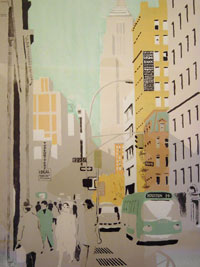Jane Freilicher: Recent Paintings (Tibor de Nagy, 724 Fifth Ave., up through Saturday). New work by an underrated artist whose deceptively quiet landscapes and still lifes reflect the influence of Bonnard and the cubists yet remain utterly American in tone and tint. (One of them is in the Teachout Museum.) Don’t be deceived by Freilicher’s soft, even-toned palette and seemingly conventional subject matter–her art is life-enhancing (TT).
Archives for January 7, 2008
TT: Back to the bustle
 I looked in the bathroom mirror when I got up on Saturday morning in Smalltown, U.S.A., and saw dark circles around both of my eyes. That was when I knew I was starting to feel the strain of two weeks’ worth of caregiving. Seventeen hours and two flights later, I was lugging my suitcases up the stairs of my Upper West Side apartment house, and an hour after that I was out cold.
I looked in the bathroom mirror when I got up on Saturday morning in Smalltown, U.S.A., and saw dark circles around both of my eyes. That was when I knew I was starting to feel the strain of two weeks’ worth of caregiving. Seventeen hours and two flights later, I was lugging my suitcases up the stairs of my Upper West Side apartment house, and an hour after that I was out cold.
The good news is that my mother’s orthopedist and physical therapist have given her excellent reviews. She’s healing nicely, has recovered her balance, and graduated last week from her walker to a cane. While she’s not quite out of the woods yet, her recovery has been much faster than anyone expected. I can’t begin to tell you how relieved I am.
Needless to say, I haven’t been sleeping very well lately, and I returned to New York to find the usual mountain of snail mail awaiting me. Fortunately I have only one deadline to hit this week, but I’m several days behind schedule on The Letter and my Louis Armstrong biography, I need to plan a playgoing trip to California, and starting on Tuesday I’ll be seeing six shows in six nights. For all these reasons and plenty more, I don’t plan to do any more blogging this week except for the usual almanac entries and theater-related postings. OGIC and CAAF will pick up the slack. If I break my word, give me hell.
See you next Monday.
P.S. No, I haven’t been answering my mail–but I will. Eventually.
FILM
Sweeney Todd. Tim Burton’s two-hour-long film version of Stephen Sondheim’s greatest musical is a devastatingly concise, horrifically bloody exercise in neo-Gothic naturalism from which all the stage-specific presentational elements of the original production have been trimmed away. The results are effective in the extreme, not least because of Johnny Depp’s cold, hard, unrelenting performance of the title role. No, the singing isn’t great, but it’s still the best film of a Broadway musical ever made, Cabaret included (TT).
TT: Almanac
 “The clock by the corner pointed to the hour of three, and Jesse Fineman had wanted to see him any time that afternoon in his office off Broadway. First he passed the restaurants on the corss street west and the windows of secondhand shops filled with bronze statuary and Arab pistols and all sorts of other articles which he could not imagine anyone’s wanting to buy. Then there were the small hotels with marble fronts and with palm trees in the lobbies. Then there were the subway entrances where the Interborough and the B.M.T. entwined beneath the street, and then Times Square. Broadway was always shabby in the afternoon. The electric signs stood nakedly against the sky like the frames of elaborate fireworks displays. Although Times Square was crowded, it all seemed half-asleep. The picture houses and the drugstores and the newsstands never seemed to try in the afternoon.
“The clock by the corner pointed to the hour of three, and Jesse Fineman had wanted to see him any time that afternoon in his office off Broadway. First he passed the restaurants on the corss street west and the windows of secondhand shops filled with bronze statuary and Arab pistols and all sorts of other articles which he could not imagine anyone’s wanting to buy. Then there were the small hotels with marble fronts and with palm trees in the lobbies. Then there were the subway entrances where the Interborough and the B.M.T. entwined beneath the street, and then Times Square. Broadway was always shabby in the afternoon. The electric signs stood nakedly against the sky like the frames of elaborate fireworks displays. Although Times Square was crowded, it all seemed half-asleep. The picture houses and the drugstores and the newsstands never seemed to try in the afternoon.
“Nothing Jeffrey saw had changed much from the way he first remembered it. There was the same cynicism, the same disregard for sobriety, the same combined efforts of millions of people to escape from what troubled them. It was all pathetic like every fallacy, but at least it was not new.
“‘Plenty of seats in just a minute,’ the men in the horizon-blue uniforms were saying. ‘The main picture will be over in three minutes. Seats now only in the mezzanine.’
“The police whistles were blowing, crowds were streaming solidly across the street. It was all more permanent than Fifth Avenue–timeless, too complicated to understand, but then, there was no reason to understand it.”
John P. Marquand, So Little Time
CD
The Complete Louis Armstrong and the Dukes of Dixieland (Essential Jazz Classics, three CDs). The greatest jazz musician of the twentieth century teamed up with a banjo-and-tuba Dixieland septet in 1959 to knock off an early-stereo LP of very standard New Orleans standards. It should have been an infallible recipe for ennui, but Armstrong caught fire, and the result was one of the liveliest and most exciting albums of his middle age, followed a year later by a similarly satisfying sequel. Both albums have now been reissued in their entirety on this three-CD set, augmented by twenty alternate takes. Take a taste of “Bourbon Street Parade” and see if it doesn’t make you feel like cooking up some of that good ol’ red beans and rice (TT).
